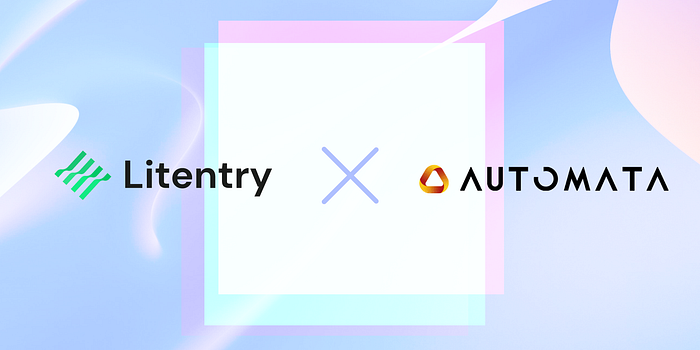
This week’s keyword: Privacy. Our tech team has been working closely with the SubstraTEE team and Automata to embed their privacy designs into our DID aggregation protocol. Dive in below to see what is happening. 👀
✨ SubstraTEE for storing linked identity information privately
Our team had a technical discussion with the SubstraTEE team to learn more about developing pallets inside their TEE framework. SubstraTEE is a very useful framework that allows calling a custom state transition function (STF) inside a Trusted Execution Environment (TEE). It promises integrity and confidentiality of (remote) computation.
With SubstraTEE, Litentry is able to build a TEE side chain that can be used to stored identity linking information in a privacy-preserving and secure manner. Specifically:
- The relationship of users’ different IDs is stored in a TEE environment. Requests sent to the TEE will be encrypted by a shielding key so that no node in the network can decrypt the information.
- Any computation work that happens inside SubstraTEE worker enclaves can’t be observed by the network nor by the operator of the worker service.
- TEEs allow us to execute any state update without sharing our data with the blockchain validator or other users. The blockchain serves as a root of trust and all the data remains inside the protected enclaves off-chain.
🔮 Automata for confidential ID score computation

We partner with Automata to strengthen privacy protection across Litentry’s Identity Score Computation Layer. Automata provides middleware-like traceless privacy services for dApps and enables a high degree of privacy for computation in Geode.
With its secure hardware approach based on Intel SGX, a Trusted Execution Environment, Automata ensures that identity computation conducted by Litentry is carried out in an isolated and shielded environment, free from the prying eyes of any malicious actors on the move. When Automata finishes computation, the result will be encrypted with the request signing key from Litentry and recorded on the blockchain. Then, the outside could decrypt the info with a private key. This ensures that no computation process or data is observable by the external and only the requestor can access the result once it’s ready to be viewed.
Through this partnership, We look to work with Automata Network to further safeguard against potential data leaks during the process of identity score generation.
🛠 Technical updates
Testnet: Xrecovery, SubstraTEE & Chainbridge
- Xrecovery pallet implementation
- Researched on SubstraTEE
- Deployed and tested Chainbridge on Testnet
Web App: Polkadot extension, hook/react component
- Webapp connected to Polkadot browser extension
- Added Polkadot hooks and React components to webbapp
- Sorted out some webpack issues that came up from installing the Polkadot library
Misc
- Chainbridge code audit discussion
- Fixed CI issues on parachain 0.9.4 v
- Added logging and error handling messages in OCW on a branch
- Researched devops tools and ansible for future deployment
- Supported twitter-linker backend & frontend
🎙 Litentry & Friends EP2: DID in instant messaging

Litentry & Friends EP2 is out! In this episode, we have invited Victoria Gavrilyuck from iMe and Lilly M.Dobreva from Litentry to talk about the potential synergy between DID & Instant messaging. Below is a selected Q&A from the panel discussion:
What’s your imagination of Litentry’s decentralized identity in instant messaging & social media?
The nature of decentralized identity is to reflect a digital self in an independent, self control way. The combination of DID and social media is natural, especially social media platforms like iMe which supports peer to peer communication with message encryption.
But enabling a decentralized registration method only gives users the essential account of communication. In social networks we need more diverse characters in reflecting our digital selves. Litentry is playing such a role in gathering decentralized identity data and aggregating decentralized identities based on specified identity computation algorithms. There many separate decentralized networks providing all kinds of internet service, but the user data do not flow between different networks because of different data structures, system languages. With Litentry, dApps developers are able to inquire a user’s decentralized identity data in one stop, for example your DeFi tracking record, your on-chain governance behaviors, your contributions in an open-sourced software, and so on. Litentry is like a middle component of connecting all the decentralized networks for identity reflection in Web3, without it it’s hard to acquire identity data in different characters in Web3, thus limiting our characteristics in decentralized social media.
👏 Thank you for reading! What’s your thoughts on our privacy approach? Leave your comment below!👇
About Litentry
Litentry is a Decentralized Identity Aggregator that enables linking user identities across multiple networks. Featuring a DID indexing protocol and a Substrate-built distributed DID validation blockchain, Litentry provides a decentralized, interoperable identity aggregation service that mitigates the difficulty of resolving agnostic DID mechanisms. Litentry provides a secure vehicle through which users manage their identities and dApps obtain real-time DID data of an identity owner across different blockchains.
